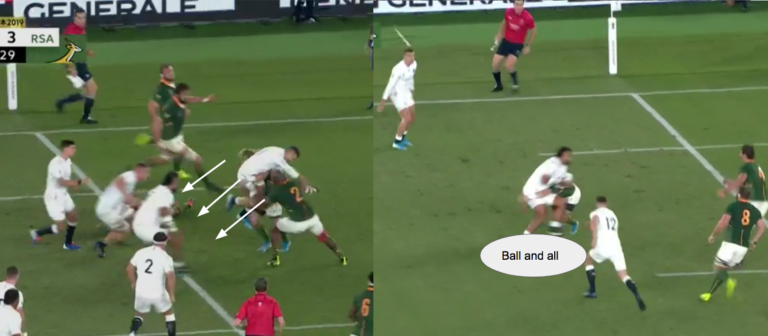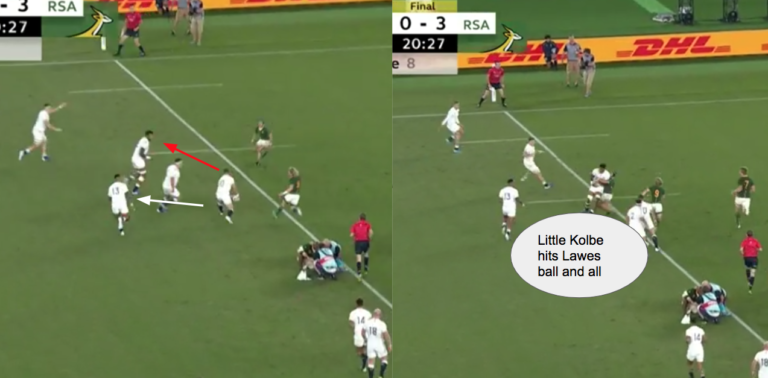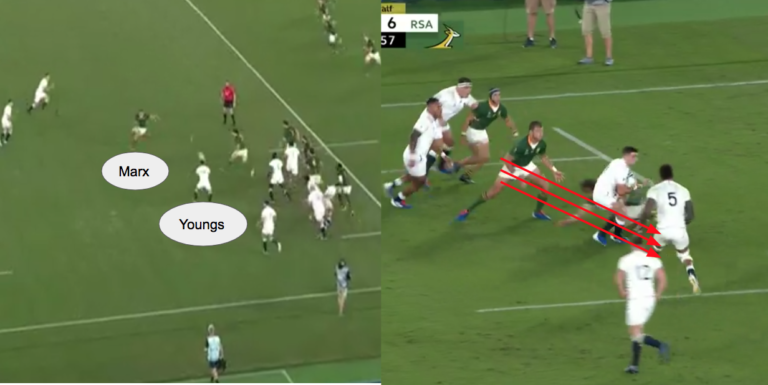A Bok defence that relies on speed, aggression and courageous decision-making shattered the confidence of England’s previously fluent attack, writes Craig Lewis.
When the Springboks faced England in the first of a three-game series in June 2018, Rassie Erasmus’ team was horribly cut open on defence as the visitors raced into a 24-3 lead.
It was all part of the teething problems under a new defensive system and coaching staff, but it’s quite remarkable how far the Boks would come just over a year later.
Against the selfsame England, in a brutal World Cup final, a painstakingly-perfected Bok defence would prove to be a key ingredient to success, as it had been all tournament.
In this Springbok defensive system, there are some crucial role players, and Faf de Klerk is certainly one of them – although many may not realise it. Despite his dimunitive stature, De Klerk is a fantastic defender. He boasts excellent tackle technique, but also the speed to hassle and hurry attacking opponents, while also getting his team out of a tricky situation sometimes.
In this example below, De Klerk assumes his commonly-used position on lineout defence, guarding the touchline. England switch the play to wing Jonny May, and he targets the trams, but is caught by De Klerk, lifted and smashed back along with a bit of arriving help from Bongi Mbonambi.
England recycle the ball and go through a couple of phases, but their ball carriers are met by massive defence from the Bok forwards. Scrumhalf Ben Youngs switches the play back to the blindside and there is a bit of space out wide, but De Klerk uses his speed and timing to expertly hit big Billy Vunipola ball-and-all. The Bok defence wraps around, Duane Vermeulen will prevent an offload, and England are unable to get the ball wide.

England will go through the phases again, and there is space to work with, but this time the speed of Makazole Mapimpi comes to the fore as he rushes up and catches Elliot Daly.

England go back the other way, and have a great attacking opportunity, but struggling George Ford fails to take the correct option. Instead of finding looping Manu Tuilagi with a pass behind, he feeds Courtney Lawes and Cheslin Kolbe makes the perfect read as he catches the big lock and brings him to ground, killing the overlap.

Using the speed of the players at their disposal, the Boks have developed a defensive system that gets under the skin of their opponents and prevents them from dictating proceedings.
In the first part of the split screen below, it’s Malcolm Marx who actually uses his mobility to get up and into the passing lane of Youngs, who has to check his pass because of the presence of Marx. A few phases later, England are desperately trying to find a way through the Bok defence, but again Ford has no option but to cut back inside as he spots Kolbe and Handre Pollard, who have rushed up and cut down his time and space.

England did everything in their power to try and find a way to break down the Bok defence. Besides being met with brutal dominant hits in the midfield, every time they tried to take it wide they were hassled by the annoying pace and organisation of the Boks’ rushing defenders who put indecision in their minds.
On more than one occasion, England look to play from deep and try and find a way around the Bok defence, but the South African players have become experts at coping with being outnumbered and finding ways to create doubt. Here Daly has plenty of space to work with, but Am and De Klerk have it covered. As Daly takes it up, he is caught by Am, while the presence of face-on De Klerk cuts the passing option after he’s left it too late.

Finally, let’s enjoy a bit of Pieter-Steph du Toit, who turned Ford’s final into a nightmare. As pointed out in another analysis piece from Oom Rugby, the Boks opted to compete at a lot less rucks in the title decider, instead allowing Du Toit to roam free on defence, and in particular he regularly shot out to torture and disrupt Ford.

All in the space of two minutes, Du Toit continues to terrorise Ford. In another example straight after the half-time restart, Du Toit uses his remarkable mobility for a big man to smash Ford just as he’s looking to pass, and the ball misses its man. Not long after, the England flyhalf is pulled from the field of play. 
All these examples show how effective the Bok defence proved to be in the final, but it wasn’t just about brutal force. It also required street smarts, pace, courage and astute decision-making.
It was both brains and brawn.
Photo by Kaz Photography/Getty Images





